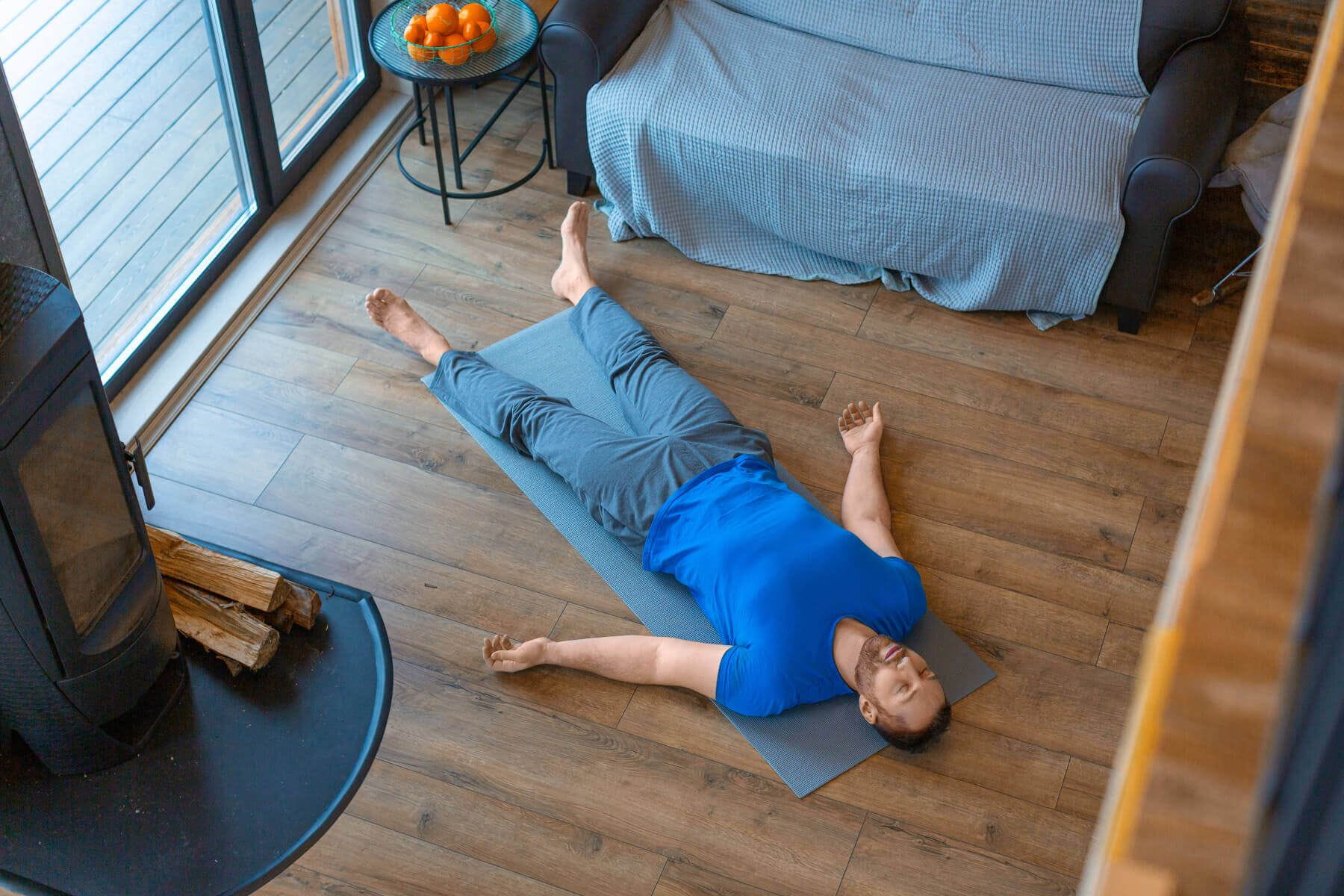
The practice of yoga delivers far more than headstands and physical postures. If you're new to this ancient practice, you're in for a treat! Yoga Nidra ("yogic sleep)" is a deeply relaxing and meditative technique that can transform how you rest and rejuvenate.
Finding true relaxation can be challenging in our busy, fast-paced lives, but Yoga Nidra offers a peaceful escape to a state of serenity and calm.
We'll explore the essence of Yoga Nidra and how it can significantly enhance your sleep quality. Whether you're a seasoned yogi or just curious about improving your sleep patterns, this post will provide insights, tips, and practices to integrate Yoga Nidra into your nightly routine.
Remember, don't be intimidated by the types of yoga or their poses. Yoga is for everyone. We'll look into the benefits, how to get started, and how it can help you sleep.
So, let's discover how Yoga Nidra can lead you to a more rejuvenating and restful sleep experience.
What is Yoga Nidra?
Yoga Nidra, an ancient relaxation method, involves guided mental visualizations while the individual lies on their back, known as Shavasana or the Corpse Pose. Those who have experienced the widely practiced Hatha Yoga, characterized by its dynamic movements, might recognize Shavasana" as the concluding pose of the session.
The term "yoga nidra" originates from the Sanskrit language and is commonly translated as "yogic sleep." This technique aims to induce a state of relaxation similar to sleep while maintaining a conscious awareness of the surroundings.
Scientific research shows that practicing this form of yoga can induce a hypnagogic state, resulting in slower brain waves. [1] Experts suggest that practicing yoga nidra can lead to a state where the body is asleep, but the mind is aware. As a result, it can be beneficial in treating insomnia.
Yoga Nidra has its roots in ancient times, but it was introduced to the general public in the 1960s. Swami Satyananda Saraswati published writings that clearly outlined the steps involved in the practice. Researchers often refer to these writings when investigating the effects of yoga nidra.
Award winning Chilipad
Save on our bed cooling systems and tubeless cooling mattress topper that quickly cools as low as 55°F. Control your bed temperature ranging from 55-115°F, so you sleep at your ideal temperature.
The Difference Between Yoga Nidra vs. Meditation
Yoga Nidra and other forms of yoga often involve elements of meditation. Meditation is intentionally directing one's attention in a specific way or noticing things without passing judgment.
There is some debate among researchers about whether Yoga Nidra is a type of guided meditation or not. Those who support this claim argue that Yoga Nidra and meditation are similar in that they both involve mental focus and relaxation techniques.
However, some disagree, noting that Yoga Nidra is done while lying down, unlike traditional meditation, which is performed while seated. Also, Yoga Nidra involves entering a sleep-like state, which is not always achieved through meditation.
Yoga Nidra is often classified as a form of yoga, but it differs from what people usually associate with the practice of yoga. Most yoga meditation practices involve holding different physical postures, but Yoga Nidra involves only one position: shavasana or lying down on one's back.
How Yoga Nidra Can Improve Your Sleep
Several research studies suggest that practicing yoga nidra can help improve sleep quality, and ongoing studies continue to explore this topic further. Current research indicates that yoga nidra can help individuals fall asleep faster and enjoy higher quality sleep. [2] The practice promotes deep sleep while reducing stress and pain, which could positively impact overall sleep health.
Practicing Yoga Nidra might enhance one's sleep by stimulating the parasympathetic nervous system while reducing the effects of the sympathetic nervous system. [3] These two autonomic nervous system components control numerous automatic processes of the body, such as blood pressure and digestion.
The sympathetic nervous system triggers the body's stress response, while the parasympathetic nervous system helps the body restore itself. Practicing Yoga Nidra can help relax the body and increase deep sleep by reducing sympathetic nervous system activity and increasing parasympathetic nervous system activity.
Yoga Nidra Benefits
In addition to improving sleep, researchers suggest practicing Yoga Nidra may offer additional benefits. Yoga Nidra is safe, affordable, non-invasive, and can be done remotely online.
Just as we gently rock a child to sleep to ease them into dreamland, adults also benefit from laying down and quieting the mind before bed. Here are some additional benefits of Yoga Nidra.
Improve Blood Pressure & More
This type of yoga meditation feels good, but science also backs up its benefits. In two separate published papers, [4] researchers found Yoga Nidra improved blood pressure and hormone irregularities in women.
Researchers at Shyam Shah Medical College measured fewer fluctuations in blood glucose levels in people with type-2 diabetes after 30 consecutive days of Yoga Nidra practice. [5]
Improve HRV
HRV stands for Heart Rate Variability, a measurement in milliseconds of the variations in time between each heartbeat. This variation or irregularity—which is perfectly normal, even for a healthy heart—is governed by a section of your nervous system known as the autonomic nervous system (ANS), which impacts your breathing, blood pressure, digestion, and heart rate.
Track Your HRV: Track core vitals that matter with our Sleep Tracker! Your HRV directly indicates how much stress your body is under at any given time. Your daily HRV tells you when to push or take it easy.
A research study in 2012 showed that it causes improvement of HRV without the physical practice of postures. [6]

Reduce Stress & Anxiety
In another study, [7] researchers analyzed short, 11-minute Yoga Nidra meditation for 30 days in a diverse sample of the population to measure its benefits.
The group given the short meditation showed “lower stress, higher well-being, and improved sleep quality after the intervention” compared to the group that did not.
Additionally, even six weeks later, the positive effects of the treatment remained stable. By simply taking a few minutes before bedtime to meditate and focus on mindfulness, you too can reap the benefits of this free, body-enriching exercise.
Recent Yoga Study: Yoga Nidra can be a helpful tool in reducing physiological and cognitive symptoms of anxiety. [8]
Reduce Symptoms of Depression
According to research, practicing yoga nidra can help reduce anxiety and improve symptoms of depression in individuals with menstrual concerns. [9] However, the study only observed improvement in those with mild to moderate depression-related symptoms, while individuals with severe symptoms did not show any improvement.
Further research is necessary to determine if yoga nidra can help alleviate depression in the general population.
Improves Confidence and Self-Esteem
Regularly practicing can improve your confidence and self-self-esteem. A recent study in 2019 looked at the effects of Yoga Nidra on life stress and self-esteem in university students.
The results showed that the group that practiced Nidra yoga showed remarkably decreased life stress intensity levels compared to the control group.
Reduces Pain Symptoms
According to several research studies, practicing Yoga Nidra, a form of deep relaxation, can be beneficial in reducing pain and discomfort caused by various health conditions.
For instance, individuals suffering from inflammation in the lumbar vertebrae, migraines, tension headaches, and menstruation-related pain or cramping may find relief through consistent practice of yoga nidra.
The practice is believed to work by minimizing the body's stress response and promoting a state of relaxation. This can help reduce muscle tension, alleviate pain perception, and provide a sense of calm that can benefit overall physical and mental well-being.
Other Benefits Include:
- Lowers Cholesterol Levels
- Reduces Addiction
- Strengthen the Immune System
- Recharges Your Energy
- Lower Blood Sugar Levels
- Slower Heart Rate
- Increased Alertness
- Lessened Anger
- and more
To experience the following benefits, it's recommended that you practice yoga nidra regularly, ideally several times a week. By incorporating yoga nidra into your self-care routine, you can reap the rewards of this powerful practice and enjoy a more peaceful and fulfilling life.
How to Do Yoga Nidra
Come to your meditation prepared to let go of the nagging worries and woes of the day. You’ll want to ensure your space is calming and cozy (if the goal of your practice is sleep, this would be the bedroom).
We have free Yoga Nidra exercises to help in your mindfulness journey. There’s no wrong way to start; all that matters is your mindset.
Give the below examples a try:

Getting Started
First, before you start, below are some basic steps to get started.
- Please browse our list of recordings.
- Our instructors read aloud the instructions to help guide you.
- Select your location with a comfortable flat surface. Prepare a yoga mat or blanket.
- Prepare your environment. Comfort is key. Enhance the area by adding a candle or incense.
- Wear comfortable loose clothing.
- Make sure your space is quiet.
Yoga Nidra Script Examples
A script is read by the yoga instructor when guiding you through the meditation. Unlike other forms of meditation, yoga sleep is always practiced with live or recorded verbal instructions by an experienced yoga instructor. There are various scripts available to follow.
Stages of Yoga Nidra
- Prepare Yourself
- Focus on Breathing
- Focus on Your Body
- Muscle Relaxation
- Visualization
- Sankalpa
- Reawaken
Final Thoughts
Yoga Nidra is taught lying down, making it a simple practice. Additionally, a yoga teacher or instructor guides you through the exercise. It is a welcome practice, especially after a long day leading up to bedtime. Yoga Nidra training can lead to your deepest sleep yet.
As with any exercise, yoga does not come without its risks. Practicing yoga should be done with respect and care, easing the chance of injury. Before starting this or another form of yoga, it's best to consult your doctor or a medical professional.
Citations/References
[1] Sharpe E, Lacombe A, Butler MP, Hanes D, Bradley R. A Closer Look at Yoga Nidra: Sleep Lab Protocol. Int J Yoga Therap. 2021 Jan 1;31(1):Article_20. doi: 10.17761/2021-D-20-00004. PMID: 33175980; PMCID: PMC8932407.
[2] Sharpe E, Tibbitts D, Wolfe B, Senders A, Bradley R. Qualitative Impressions of a Yoga Nidra Practice for Insomnia: An Exploratory Mixed-Methods Design. J Altern Complement Med. 2021 Oct;27(10):884-892. doi: 10.1089/acm.2021.0125. Epub 2021 Jul 15. PMID: 34265219.
[3] di Fronso S, Bertollo M. The Thin Line Between Waking and Sleeping in Athletes: A Call for Yoga Nidra in the Sporting Context. Front Psychol. 2021 May 21;12:654222. doi: 10.3389/fpsyg.2021.654222. PMID: 34093343; PMCID: PMC8175770.
[4] Amita, S., Prabhakar, S., Manoj, I., Harminder, S., & Pavan, T. (2009). Effect of yoga-nidra on blood glucose level in diabetic patients. Indian journal of physiology and pharmacology, 53(1), 97–101.
[5] ibid.
[6] Markil, N., Whitehurst, M., Jacobs, P. L., & Zoeller, R. F. (2012). Yoga Nidra relaxation increases heart rate variability and is unaffected by a prior bout of Hatha yoga. Journal of alternative and complementary medicine (New York, N.Y.), 18(10), 953–958. View Study
[7] Moszeik, E.N., von Oertzen, T. & Renner, KH. Effectiveness of a short Yoga Nidra meditation on stress, sleep, and well-being in a large and diverse sample. Curr Psychol (2020). View Study
[8] Ferreira-Vorkapic, C., Borba-Pinheiro, C. J., Marchioro, M., & Santana, D. (2018). The Impact of Yoga Nidra and Seated Meditation on the Mental Health of College Professors. International journal of yoga, 11(3), 215–223. View Study
[9] Rani, K., Tiwari, S., Singh, U., Singh, I., & Srivastava, N. (2012). Yoga Nidra as a complementary treatment of anxiety and depressive symptoms in patients with menstrual disorder. International journal of yoga, 5(1), 52–56. View Study
[10] Stankovic L. (2011). Transforming trauma: a qualitative feasibility study of integrative restoration (iRest) yoga Nidra on combat-related post-traumatic stress disorder. International journal of yoga therapy, (21), 23–37.






